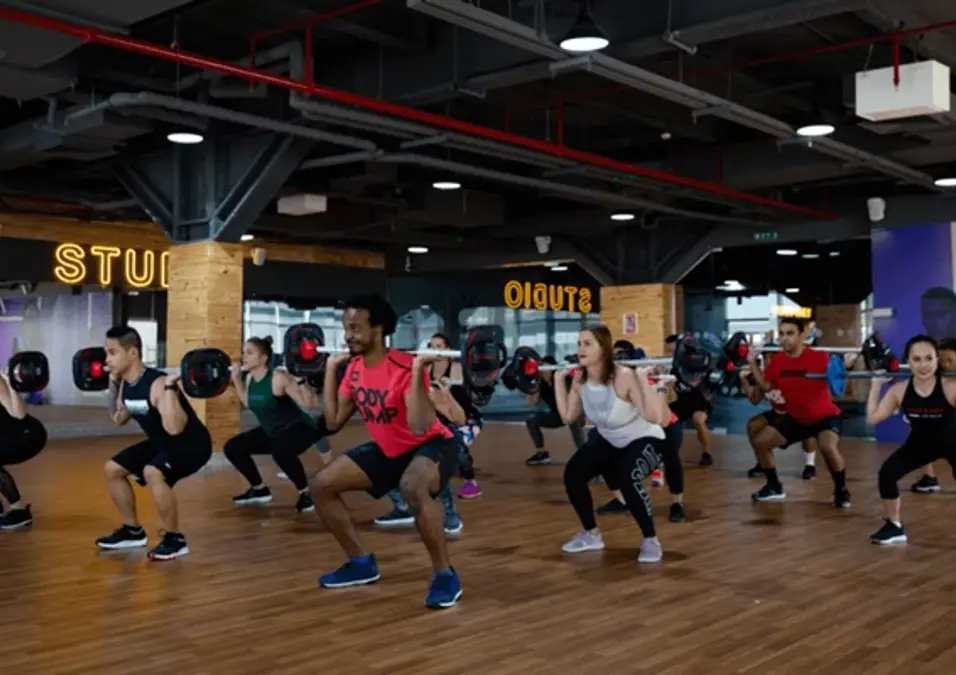Top 3 squat variations

SIGN UP FOR YOUR FREE DAY PASS TODAY!
Never skip leg day. Come on.
There will be members in any gym, anywhere in the world, who have shoulders that go out forever, bulging arms and chiselled pecs, but whose legs are like pieces of string.
This sucks. Of course, there is an aesthetic element: any muscular imbalances ruin the whole picture, and there is no doubt that these swollen torsos stuck on top of match sticks look foolish. However, the improved power and performance that comes from having strong, robust legs capable of squatting multiple times your bodyweight is a must for any serious-minded athlete or if you go to gyms in Dubai.
Though there are literally hundreds of exercises and training styles for increasing leg size and strength, the humble yet profound squat is amongst the most common, most accessible forms to anybody.
Not all squats are created equally, however. We should take it for granted that you are aware of, and regularly performing, regular bodyweight and rear loaded barbell squats. If you’re not, stop reading, and go and practice them. This is the first step in any gym regime worth a damn.
If you are performing these but want a little variety- and the truly profound gains that come from some of the harder squat variations- then read on. Below, we have gathered the three top squat variations that any weightlifting regime needs to include.
Though there are plenty of options for training, including performing squats at home, or in a garage gym, the best way may be to join your local gym. It’s inexpensive, gives you the focus of being in a separate space, and will come with plenty of equipment. There are plenty of gyms in Dubai, and plenty of gyms in Abu Dhabi, so finding a gym near you for exercise several times per week should be easy enough to do. If in doubt, simply Google ‘Gyms Near Me’, pick one with a good rating, and give them a call.
1. The barbell front squat
This is a personal favourite and is arguably better for hypertrophy and overall athletic performance than its rear-loaded brethren.
Whilst the rear loaded squat is posteriorly loaded, the front squat is anteriorly loaded. This carries a few ramifications.
The first is that, as the front squat is most often loaded in a power rack, a lot of weight is usually used. In fact, it is one of the heaviest loads your anterior will generally deal with. The strength carryover into your core will be tremendous, and a stronger core will lead to stronger… everything, really.
Secondly, those who struggle with leaning forwards in the regular squat will be able to maintain a better, more upright position in the front squat. It also hits the quads a lot harder than the rear-loaded squat, leading to greater hypertrophy through this range.
Those lacking wrist or shoulder mobility will struggle with a traditional front squat, as they will with any other anterior loaded barbell exercise. There are variations to get around this, like using straps or changing your arm position to a cross. However, it’s also a sign that you have some mobility work to be getting on with: for many, simply getting into a front rack position is a worthy goal in its own right.
2. The goblet squat
Personal trainers often begin their new clients with goblet squats in a bid to teach them correct movement patterns. There is a good reason for this: goblet squats are easy enough to pick up, they can be programmed with very low weights, and they require, and lead to, full body control.
However, this has given them something of a reputation as a beginner’s movement and nothing more. This isn’t true: even the most advanced athletes will benefit from regularly including goblet squats in their training regimes.
The goblet squat will use similar movement patterns to the front squat, and will elicit similar results, meaning that it will be useful for those who tend to lean forwards too much in a back squat, or those who want an extra bit of core stimulation during their training.
Though they cannot go as heavy as other squat variations (due to the weight being held in your hands), goblet squats can still go pretty heavy. The Best Personal trainers recommend using heavier kettlebells or sandbags: the core activation and quad fatigue you will experience will be quite profound.
Goblet squats are also great for use at high rep ranges. Give them a go as an assistance move in the 12 rep range, after your main leg exercise, or else throw them into your HIIT and superset routines for a real pump through your core and legs.
3. The Bulgarian split squat
Bulgarian split squats are pretty hard core, as finishers for intensity and endurance, as mass builders for hypertrophy, and as heavy reps for strength. They will really get into your quads, whilst still putting a great deal of stimulation into your glutes, and will work hamstring and posterior chain activation into the bargain.
Personal trainers will recommend that if you’re after strong, well-built legs, you need to include split squats in your routines.
Specifically, the rear leg elevated, dumbbell split squat is a great mass and strength builder. Use two pretty heavy dumbbells, one in each hand, and elevate your rear foot on a bench, step or block. Keep your arms neutral, trying not to swing, and go through the reps.
It will hurt like walking lunges and it will require the kind of strength that only champion squatters bring to bear. You’ll hate it, but you’ll grow.
GET YOUR FREE TRIAL TODAY
















































































